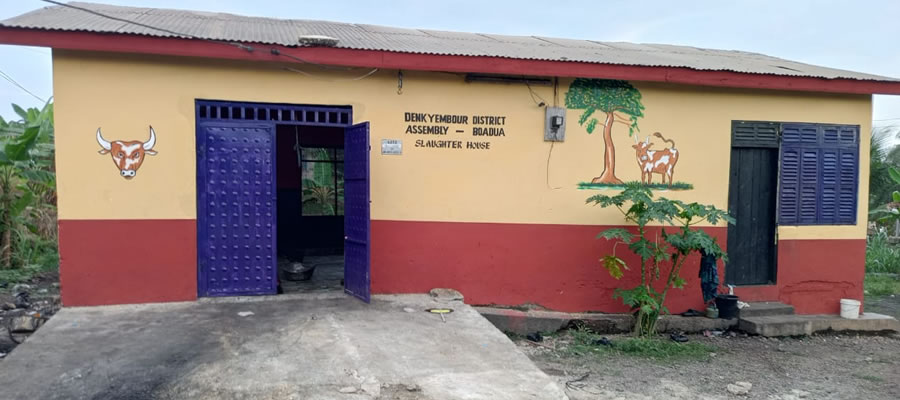

Main Source of Water for Drinking and For other Domestic Use
It is observed that, the main source of water used by households for drinking are bore hole/pump/tube well (22.2%), protected wells (20.9%), Pipe borne water outside dwellings (17.9%) and public tap/standpipe (17.1%). In all, nearly half (45.5%) of households have pipe borne water as their main source of drinking water.
The bore hole/pump/tube well is the most common source of drinking water used by rural households (36.4%), followed by protected wells (20.7%).
However, urban households rely more on pipe born outside dwelling (20.3%) and public tap/stand pipe (22.2%) for drinking. Only 9.6 percent of households in the district use sachet water although majority (12.8%), are urban households. Only 4.3 percent of household use the river /stream, as their main sources of drinking water with almost 1 out of 10 rural households drinking from river/stream.
With regard to the main source of water used by households for other domestic activities, the picture is not different from the sources for drinking. Protected well is the most common source of water used by households in the district for other domestic activities.
The bore hole/pump/tube well, public stand pipe, unprotected well, and pipe borne outside dwelling are four other main sources of water for domestic activities. Again, put together, pipe borne constitute 40.6 percent of water used for other domestic activities in households in the district. The use of the four sources except bore hole/pump/tube well is more than 20 percent of households in the urban areas in the district Rural households use more of two sources, bore hole, pump/tube well and unprotected well for other domestic activities.
Bathing and Toilet Facilities
Toilet facilities
Public toilets are the most commonly used toilet facilities in the district and accounts for 37.8 percent. Again, 30.9 percent of households use pit latrines. About 1 out of every 10 households (9.1%) of households has no toilet facilities and use the bush, fields and banks of rivers as toilet facilities. Only 6.6 percent of households use the WC and 0.2 percent of households still use bucket or pan even though this has been banned in the country.
12.8 percent of households in rural areas do not have any toilet facility compared to 6.5 percent of urban households. Whereas 43.3 percent of urban households and 30.2 percent of rural households use the public toilet, the picture is different with regards the use of pit latrines; more rural households (42.5%) compared to 22.4 percent of urban households use pit latrines.
Bathing facilities
A little above a third (36.6%) of households in the District share separate bathrooms in the same house. Nearly 2 out of 10 households (18.5%) share open cubicles whereas 24.0 percent own bathrooms for exclusive use. More rural households use open space around the` house and bathroom in another house than urban households. On the other hand, the proportion of urban households who share separate bathrooms in the same house and shared open cubicles as bathing facilities is higher than rural households.
Method of Waste Disposal
Public dumps are the most common outlet of solid waste disposal in the District. Majority of households either dispose solid waste through public dumps in containers ( 23.3%) or public dumps in open spaces (46.7%). Burning of waste by household (18.7%) is the second most commonly used solid waste dumping outlet while 7.7 percent households indiscriminately dispose of their solid waste. Collection of waste from households is not highly patronized as only 2.0 percent of households use this method in the district.
With regards to the locality of residence, dumping of solid waste in public containers is most common in the urban areas (23.3%) than rural areas. Less than two percent of rural households in the district dump solid waste in public containers. The most commonly used solid waste disposal by rural households is the public dumps in open spaces (60.7%). Indiscriminate dumping is more common among rural households (13.6%) than urban households (3.1%). More urban households (20.8%) burn their solid waste compared to 15.7 percent of rural households.
Statistics further shows that the most commonly use method of disposing liquid waste in the district is throwing onto compound and nearly half (48.3%) of households use this method, whiles a fifth (21.1%) dispose of their liquid waste by throwing them onto the street/outside with only 1.7 percent disposing their liquid waste through the sewerage system. More rural households (31.2%) than urban households (14.0%) throw their liquid waste onto the street/outside whereas disposal of liquid waste into gutter is more common among urban households (27.5%) than rural households (10.8%). Less than two percent of households in the District dispose-off their liquid waste through the sewerage system.
Date Created : 11/24/2017 2:37:48 AM













 facebook
facebook
 twitter
twitter
 Youtube
Youtube
 +233 593 831 280
+233 593 831 280 0800 430 430
0800 430 430 GPS: GE-231-4383
GPS: GE-231-4383 info@ghanadistricts.com
info@ghanadistricts.com Box GP1044, Accra, Ghana
Box GP1044, Accra, Ghana